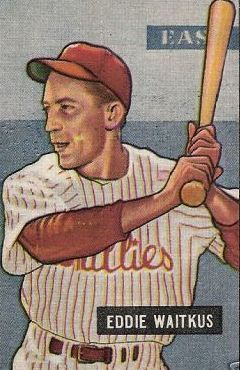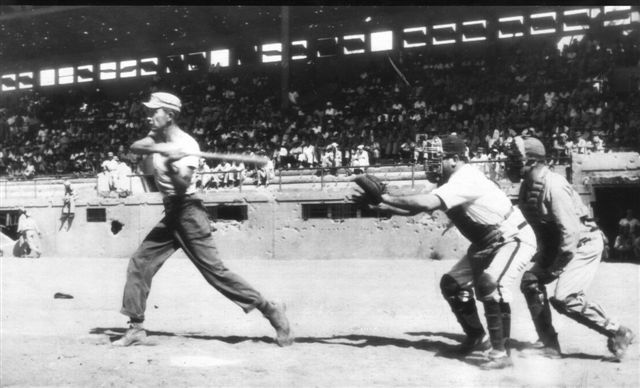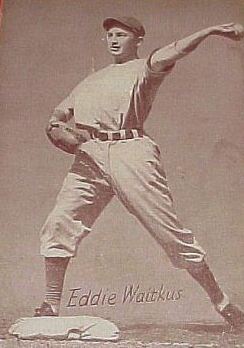

|
|
Eddie Waitkus
Date and Place of Birth: September 4, 1919 Cambridge, Massachusetts
Died: September 16, 1972 Jamaica Plain, Massachusetts
Baseball Experience:
Major League
Position: First Base
Rank: Sergeant
Military Unit: 544th Engineer Boat & Shore
Regiment, 4th Engineer Special Brigade US Army
Area Served: Pacific Theater of Operations
Eddie Waitkus, Chicago Cubs rookie infielder, revealed today that he has been drafted into the army.
International News Service February 5, 1943
He
played for Moline of the Three-I League in 1939 and joined Tulsa of
Texas League in 1940, remaining there for 1941 and appearing in 12
late-season games for Chicago. He went to spring training with the
Cubs in 1942 but was farmed to the Los Angeles Angels in the Pacific
Coast League where he finished third in the league with a .336
batting average and led the circuit with 235 hits.
Waitkus was again invited to the Cubs spring training camp in
January 1943, but the following month he was drafted and joined the
US Army.
Corporal Waitkus served at Camp Edwards, Massachusetts with the Army
engineer amphibian command. Playing baseball for the Camp Edwards’
team, the left hander broke his right arm in the first inning of a
game when he collided with another player.
In
1944, Waitkus was in the Pacific with the
544th
Engineer Boat & Shore Regiment, 4th Engineer Special
Brigade. He was at Bougainville, New Guinea in March 1944, and then
in September 1944, he took part in the amphibious landings at
Marotai in the
Dutch
East Indies. In November 1944, National League president Ford Frick
received a letter from Waitkus describing the operation as being “like
stealing home in a ball game. If it worked, swell! If it failed, it
looked idiotic.
"As
the boats circle and head for shore,” he continued, “you get a
feeling like opening day. You check your rifle a hundred times. I
was in one of the first waves. We hit in deep water, had to go in
over our heads. It's a seemingly endless stretch through the water
to the shore, but finally we made it. "A machine gun got a Jap
sniper pinned up in a tree just as we hit. On shore there wasn't
much opposition, and right now, things are coming under control. I
can't help but respect the men who planned this one, the strategy
that gave us the benefit of the element of surprise and saved a lot
of lives.
“I
don't know where or when we hit again. All our bats, balls and
gloves are packed away. The fellows would like to break them out in
the Philippines, but that's up to the fates and General MacArthur.
All I can say about the place we hit is that, it's in the
Netherlands East Indies. Nothing like Wrigley Field, either!”
In
January 1945, Waitkus was a part of the landings at Lingayen in the
Philippines. He again wrote to Frick describing the operation:
Dear Mr Frick. Chalk up another landing, and more points
for a discharge when this is over. This operation was
really big league. Our convoy coming here was under
constant attack. We had our first experience with
suicide bombing, and our navy fliers giving us cover did
a terrific job of assisting the bombers to the suicide
they wanted.
The pre invasion bombardment was a thing of beauty if
you were watching it from our side. I got through the
landing with the loss of nothing worse than a steel
helmet and a lot of dignity when my pack got caught in a
rope ladder going over the side.
After the shelling, the natives started to drift back,
and to say they were glad to see us is putting it
mildly. The Japs gave them a bad time. Most of them can
talk English even the kids even play scrub with a ball
weaved from palm leaves… For other details of what is
going on now see your papers. They probably know more
than I do. No mail has been around for about two weeks
so we might as well be in a world of our own.
Not much more to add now, so I’ll close with my latest
brain storm. If you could bring the games better known
stars back from overseas (Greenberg, Lewis, etc) to play
a war bond game in, say New York, admission by bond,
I’ll bet a Jap peso you could sell a billion dollars
worth. Nothing like ideas to while away the hours.
Sincerely – Ed Waitkus
Waitkus at bat in a game
against the Navy at Rizal Stadium in the Philippines, May
1945
Waitkus had had little
time for baseball but in the Philippines he did get into a few
games. "We got beat,” he told a friend in a letter describing a game
against the 145th Infantry, “but I got 3 for four and had a good
day. Ran into Morrie Arnovich here. If we don't move out we're
playing his team soon. It's supposed to have been the first game
played here since the Japs came about three years ago. It was swell
to play again, and we'll have plenty of baseball for a while at
least.”
In a game against the 594th Engineer
Boat & Shore Regiment, Waitkus later remembered how $60,000 was
wagered by soldiers from the two units. Just before the game he met
Fred Martin, a Cardinals' pitcher who was with a field artillery
unit that had no connection with either of the contending regiments.
"I
had no trouble getting him to agree to pitch," Waitkus recalled.
"Martin didn't belong to our regiment, but we made it legal by
having him attached to the 544th for rations and quarters. He
pitched a great game for us, winning 1-0."
In December 1946, Waitkus was voted Rookie
of the Year by the Baseball Writers’ Association of America.
Waitkus hit .292 in 1947 and .295 in 1948 as an all-star selection.
He was traded to the Phillies for 1949 and was the victim of one of
the most bizarre incidents in baseball history.
Ruth Ann Steinhagen, a 19-year-old from Chicago, was obsessed with
Waitkus, and plotted his murder and her suicide to keep others from
possessing him. On June 14, 1949, Steinhagen checked into the
Edgewater Beach Hotel in Chicago, where the Phillies’ players were
staying. She gave a note to a bellhop to give to Waitkus asking him
to come to her room to discuss important business. Believing the
note to be valid, Waitkus went to Steinhagen’s room where she met
him with a .22 rifle and shot him.
Waitkus survived but underwent five operations*. Amazingly he was
back with the Phillies the following season. He remained with the
Phillies through 1953 and was sold to Baltimore in 1954, retiring
from the game after the 1955 season, aged 36.
Eddie Waitkus led a quite life in retirement. In later years he was
an instructor at Ted Williams’ summer baseball camp. He had been
working as a floor manager at a department store in Waltham,
Massachusetts, until he died from cancer of the esophagus at the
Veterans Administration Hospital in Boston on September 16, 1972. He
was 53 years old.
*Steinhagen was declared insane and sent to the state mental
hospital in Kankakee. The Waitkus shooting was to be the inspiration
behind Bernard Malamud’s novel, The Natural, which later became a
movie featuring Robert Redford.
Created March 7,
2007. Updated March 12, 2011.
Copyright © 2011 Gary Bedingfield (Baseball
in Wartime). All Rights Reserved.


